validation
冷链运输VALIDATION验证解决方案
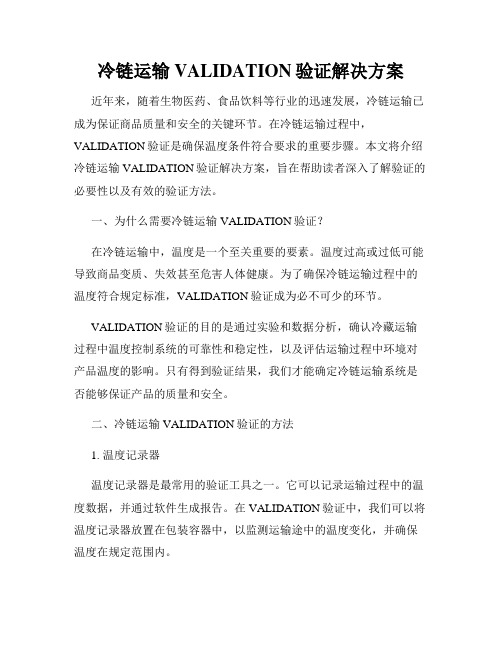
冷链运输VALIDATION验证解决方案近年来,随着生物医药、食品饮料等行业的迅速发展,冷链运输已成为保证商品质量和安全的关键环节。
在冷链运输过程中,VALIDATION验证是确保温度条件符合要求的重要步骤。
本文将介绍冷链运输VALIDATION验证解决方案,旨在帮助读者深入了解验证的必要性以及有效的验证方法。
一、为什么需要冷链运输VALIDATION验证?在冷链运输中,温度是一个至关重要的要素。
温度过高或过低可能导致商品变质、失效甚至危害人体健康。
为了确保冷链运输过程中的温度符合规定标准,VALIDATION验证成为必不可少的环节。
VALIDATION验证的目的是通过实验和数据分析,确认冷藏运输过程中温度控制系统的可靠性和稳定性,以及评估运输过程中环境对产品温度的影响。
只有得到验证结果,我们才能确定冷链运输系统是否能够保证产品的质量和安全。
二、冷链运输VALIDATION验证的方法1. 温度记录器温度记录器是最常用的验证工具之一。
它可以记录运输过程中的温度数据,并通过软件生成报告。
在VALIDATION验证中,我们可以将温度记录器放置在包装容器中,以监测运输途中的温度变化,并确保温度在规定范围内。
2. 温度映射温度映射是一种全面评估冷链运输系统的验证方法。
通过在冷藏车、冷库或运输容器中放置多个温度探头,可以测量不同位置的温度。
这样可以确保整个冷链运输系统的温度均匀性,并确定是否存在温度波动或漏洞。
3. 其他验证工具除了温度记录器和温度映射,还有一些其他验证工具可用于冷链运输VALIDATION验证。
例如,湿度计可以检测运输过程中的湿度变化,压力计可以测量冷藏运输容器的压力等。
根据具体的需求,我们可以选择适当的验证工具来评估冷链运输的需求。
三、冷链运输VALIDATION验证的注意事项1. 制定验证计划在进行VALIDATION验证之前,制定验证计划非常重要。
验证计划应包括验证的目的、方法、验证工具和验证标准等。
Validation、Verification、Qualification的区别

Validation、Verification、Qualification的区别制药都离不开GMP,而GMP总是少不了确认和验证。
那么确认和验证到底有什么区别?要搞清楚这个问题,就必须要理解三个词Validation,Qualification 和Verification的英语原意。
不过在讲解这三个词之前,请想象一下如果一个正在学中文的外国朋友问你:“街”、“道”和“路”有什么区别您如何回答呢?我们理解“Verification”、“Qualification”和“Validation”可能就像外国人理解“街”,“道”和“路”的区别,可能永远达不到那种“只可意会不可言传”的境界。
Verification这个词来自于英语的Verify。
意思是“to find out a fact or statements…etc. is true去核实一个事实或说法是真实的”,也就是查验(check)的意思。
其隐含的意义是“已经有某个事实或说法存在”,而这个动作就是找出这个事实或说法是真实的。
举个例子,我们可以说:“请verify张三是不是一个GMP审核员”。
这个动作的隐含前提是已经有“张三是GMP审核员”的说法存在了。
制药界对这个词的翻译重要性尚没有共同认可。
目前最贴切的翻译是“确证”。
Qualification这个词制药界的朋友都非常熟识,来自于Qualify,一直被公认翻译为"确认"。
可是估计很少有人真正理解Qualify是什么意思。
其原意是指"to pass an exam or meet the standards of something", 即"达到了一定的标准,从而能够做某种事情"。
设备的Qualification是其原意的延伸,即某个设备达到了一定的标准,可以被用来做某个预定的生产步骤。
Qualification的过程一定要有"预定的标准"。
validation实现原理

validation实现原理在机器学习中,训练模型的主要目标是通过数据来获得一个能够泛化到新数据的模型。
为了确保模型的泛化能力,需要将数据集划分为训练集和验证集。
具体地说,数据集通常被划分为三个部分:训练集、验证集和测试集。
训练集用于训练模型,验证集用于选择模型的超参数或进行模型选择,而测试集则用于评估模型的性能。
在训练过程中,模型会根据训练集的数据进行参数更新,不断优化模型的拟合能力。
然而,如果模型在训练集上过分拟合,可能会导致对新数据的泛化能力很差。
为了避免这种情况,要在训练过程中通过验证集来监控模型的性能。
验证集的主要作用是用于选择模型的超参数或进行模型选择。
通过在验证集上评估不同超参数或不同模型的性能,可以选择出最佳的模型。
常见的方法包括交叉验证、留出法和自助采样等。
交叉验证是一种常用的验证方法,它将训练集进一步划分为K个不重叠的子集,然后使用K-1个子集作为训练集,剩下的子集作为验证集。
这样可以对K个模型进行训练和验证,得到它们的性能指标。
最后,可以通过平均或选择最优的性能指标来选择最佳的模型或最佳的超参数。
留出法是另一种常用的验证方法,它将数据集划分为训练集和验证集两部分,通常将数据集的一定比例留出作为验证集。
然后使用训练集进行模型训练,使用验证集评估模型的性能。
自助采样是一种基于有放回抽样的方法,它通过在训练集中随机有放回地选择样本,构建多个训练集。
然后将这些训练集分别用于模型训练和模型验证,最后通过平均或选择最优的性能指标来选择最佳的模型或最佳的超参数。
总之,验证的实现原理是通过划分数据集为训练集和验证集,监控模型在验证集上的性能指标,例如准确率、精确率、召回率等,以选择最佳的模型或最佳的超参数。
常用的方法包括交叉验证、留出法和自助采样等。
冷链运输VALIDATION验证技术

冷链运输VALIDATION验证技术在如今全球化的市场环境中,冷链运输扮演着关键的角色,确保食品和药品等易腐败商品的质量和安全。
冷链运输VALIDATION验证技术是一种核心的解决方案,帮助企业实现冷链运输的有效控制和管理。
本文将介绍冷链运输VALIDATION验证技术的概念、流程和应用,为阅读者提供一个全面的了解。
一、概念冷链运输VALIDATION验证技术是指根据国际标准和监管要求,对冷链运输中的各项环节进行验证和确认,以确保货物在整个运输过程中始终保持在合适的温度和湿度条件下,从而保障其质量和安全。
二、流程冷链运输VALIDATION验证技术的流程包括以下几个主要步骤:1.需求分析和规划:首先,根据货物的特点和运输需求,确定验证的目标和范围。
同时,制定验证计划和时间表。
2.系统设计和设备选型:根据验证的目标,设计和选择合适的监测设备和传感器。
这些设备可以实时监测温度、湿度和其他关键参数,并记录数据。
3.验证执行:在货物运输过程中,持续监测和记录关键参数的数据。
这可以通过各种监测设备和传感器实现。
同时,进行必要的校验和校准,确保数据的准确性和可靠性。
4.数据分析和报告:根据收集到的数据,进行数据分析和处理。
生成验证报告,对运输过程中的异常情况和潜在风险进行评估和分析。
5.持续改进和监控:根据验证的结果,进行持续改进和优化。
制定和执行控制措施,以确保货物的质量和安全。
三、应用冷链运输VALIDATION验证技术在各个行业中都有广泛的应用。
以下是一些典型的应用场景:1.食品行业:冷链运输VALIDATION验证技术在食品行业中起到至关重要的作用。
对于易腐败的食品来说,保持适宜的温度和湿度条件对于保证其质量和安全至关重要。
2.药品行业:药品的质量和有效性与其储存和运输条件密切相关。
冷链运输VALIDATION验证技术在药品行业中可以帮助企业合规,确保药品在整个供应链中保持稳定的温度和湿度。
3.化妆品行业:某些化妆品成分对温度和湿度比较敏感,需要在运输过程中进行严格的控制和监测。
15 (对Qualification, Validation, Verification三个术语混淆分析及理解的一些建议 20150114)

对Qualification, Validation, Verification三个术语混淆分析及理解的一些建议宋启国 20150114引言即使到了今天,在制药行业,依然对以上三个词混淆的人估计不在少数。
今天,我们来做一个简单的探讨,看看混淆是如何形成,文章还对消除混淆给出了建议。
看完此文,希望能帮助你理解这三个词的真正内涵,不再混淆。
正文一切混淆起源于从英文将其翻译成中文时由于中英文语言差异,那我们先看看下表,从表中可见,我们制药行业并未采用其他行业通用的术语翻译,而是自成一套,经过这些年的生根发芽,制药行业这种自成一体的术语翻译已经根深蒂固,深入人心,于是也就愈发混淆了。
注意:为了避免混淆,本文在涉及到这三个文字时一律使用英文。
对于这三个词,在制药行业,其实简单区分为Validation用于系统、软件和方法(程序);Qualification用于设备、仪器、及杂质(是否处在安全水平,具体见ICH Q3A);Verification用于药典方法的使用(欧盟Validation and Verification附录又增加了Verification的使用,见后文介绍)。
Qualification是针对东西是否合格的,属于合格与否的资格性认可,可以是competence(人),也可是capability(系统/仪器/设备),可进一步细分为(D/I/O/PQ,4Q)。
通常,Qualification又是validation的一个初始阶段的工作,而Validation是在qualification的基础上(人和仪器设备具备资格后),针对整个系统的确认,故有时广义上用它来代替整个确认。
这个很好理解。
我们做任何事情都需要先有合格的人和仪器设备(Qualification),然后再加上有效地方法或程序(Validation)这三个要素,这就构成了我们制药行业的Validation (合格的人+合格的机器+有效的方法/程序)。
validation 密码正则
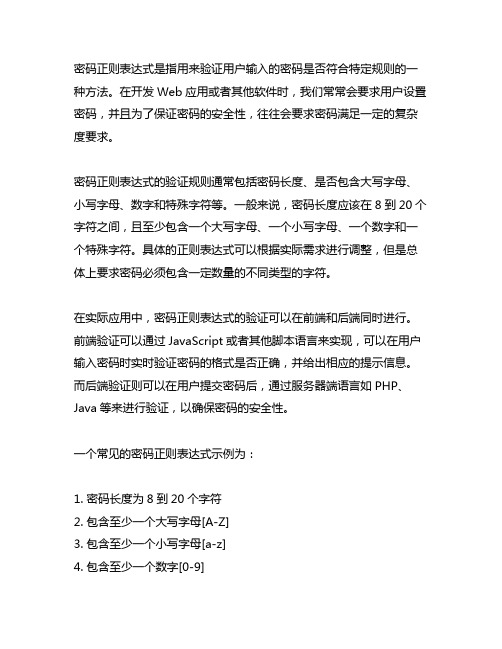
密码正则表达式是指用来验证用户输入的密码是否符合特定规则的一种方法。
在开发Web应用或者其他软件时,我们常常会要求用户设置密码,并且为了保证密码的安全性,往往会要求密码满足一定的复杂度要求。
密码正则表达式的验证规则通常包括密码长度、是否包含大写字母、小写字母、数字和特殊字符等。
一般来说,密码长度应该在8到20个字符之间,且至少包含一个大写字母、一个小写字母、一个数字和一个特殊字符。
具体的正则表达式可以根据实际需求进行调整,但是总体上要求密码必须包含一定数量的不同类型的字符。
在实际应用中,密码正则表达式的验证可以在前端和后端同时进行。
前端验证可以通过JavaScript或者其他脚本语言来实现,可以在用户输入密码时实时验证密码的格式是否正确,并给出相应的提示信息。
而后端验证则可以在用户提交密码后,通过服务器端语言如PHP、Java等来进行验证,以确保密码的安全性。
一个常见的密码正则表达式示例为:1. 密码长度为8到20个字符2. 包含至少一个大写字母[A-Z]3. 包含至少一个小写字母[a-z]4. 包含至少一个数字[0-9]5. 包含至少一个特殊字符[,!,#等]通过上述规则,我们可以得到一个基本的密码正则表达式:^(?=.*[A-Z])(?=.*[a-z])(?=.*\d)(?=.*[$!*?])[A-Za-z\d$!*?]{8,20}$这个正则表达式可以满足常见的密码复杂度要求,但是也可以根据实际情况进行调整。
在实际应用中,我们可以根据需求对密码正则表达式进行定制,以满足特定的安全性要求。
在开发过程中,密码正则表达式的验证是确保用户密码安全性的重要一环。
合理的密码正则表达式可以保证用户设置的密码符合安全性要求,从而提高系统的安全性。
合理设计和使用密码正则表达式是开发过程中不可或缺的一部分。
密码正则表达式在现代软件开发中具有重要的意义,通过合理设计和使用密码正则表达式,可以有效保障用户密码的安全性。
Validation(有效性鉴定

Validation(有效性鉴定Process Validation有效性鉴定P rocess V alidation 有效性鉴定About The Course关于该培训Background for the training背景–P&G QAKE KE6Not a Training but a forum讨论?Raise question any time欢迎提问?Time:2-3hrsObjective学习本课程要求达到的⽬标1.有效性鉴定的基本概念和其重要性2.有效性鉴定的种类和⽅法。
3.有效性鉴定系统和主计划4.编写与执⾏有效性鉴定协议草案与报告What is Validation?什么是有效性签定什么是有效性签定??Validation is establishing documented evidence that a specific process will consistently produce a product meeting its pre-determined specifications and quality attributes.有效性签定是⽂件化地证实⼀个⼯艺过程能够持续地⽣产符合既定规格或质量要求的产品. ProcessMaterial Machine MethodProductEquipmentdesign features(e.g.ProcessConditions(e.g,temp,Physical property orfunction of material(e.g.,thickness,Actions criticalfor quality(e.g.,positioning,Skillsrelated toQ-TasksMachine Material Methods huMan What is Process?什么是⼯艺过程Why Important为什么有效性鉴定重要Cost(minimize re-work,reduce scrap)by process control成本(减少返⼯,报废)Those not be able to be verified by inspection某些不能事后检验Quality(guarantee quality product to the consumer–same quality every time)保证向⽤户提供优质稳定产品Speed to the market(do it right1st time)加速进⼊市场(⼀次做好)Regulatory Basis(the law)法规的需要Food and Drug Requirement(Drugs&Devices)药品和医疗器械要求Required by P&G(via the Key Elements)Any system that is designed to deliver specific conditions for the production of a specified product.任何设计⽤于为⼀个专门产品的⽣产提供专门条件的系统。
Validation(有效性鉴定

Process Validation有效性鉴定P rocess V alidation 有效性鉴定About The Course关于该培训•Background for the training背景–P&G QAKE KE6•Not a Training but a forum讨论•Raise question any time欢迎提问•Time:2-3hrsObjective学习本课程要求达到的目标1.有效性鉴定的基本概念和其重要性2.有效性鉴定的种类和方法。
3.有效性鉴定系统和主计划4.编写与执行有效性鉴定协议草案与报告What is Validation?什么是有效性签定什么是有效性签定??•Validation is establishing documented evidence that a specific process will consistently produce a product meeting its pre-determined specifications and quality attributes.有效性签定是文件化地证实一个工艺过程能够持续地生产符合既定规格或质量要求的产品.ProcessMaterial Machine MethodProductEquipmentdesign features(e.g.ProcessConditions(e.g,temp,Physical property orfunction of material(e.g.,thickness,Actions criticalfor quality(e.g.,positioning,Skillsrelated toQ-TasksMachine Material Methods huMan What is Process?什么是工艺过程Why Important为什么有效性鉴定重要Cost(minimize re-work,reduce scrap)by process control成本(减少返工,报废)Those not be able to be verified by inspection某些不能事后检验Quality(guarantee quality product to the consumer–same quality every time)保证向用户提供优质稳定产品Speed to the market(do it right1st time)加速进入市场(一次做好)Regulatory Basis(the law)法规的需要»Food and Drug Requirement(Drugs&Devices)药品和医疗器械要求»Required by P&G(via the Key Elements)Any system that is designed to deliver specific conditions for the production of a specified product.任何设计用于为一个专门产品的生产提供专门条件的系统。
validate表单验证

jQuery 表单验证插件——Validation(基础)(2011-04-23 15:10:21)转载▼分类:javascript标签:杂谈jQuery 表单验证插件——ValidationValidation插件式历史悠久的jQuery插件之一,经过了全球各种项目的验证,得到了很多WEB开发者的好评,作为一个表单验证的解决方案,Validation有很多的优点,比如:内置的验证规则,如:必填、数字、E-Mail、URL和信用卡号码等19类内置验证规则可以自定义验证规则:可以很方便地自定义验证规则简单而且强大的验证信息提示:没人了验证信息提示,并提供自定义覆盖默认提示信息功能实时进行验证的功能.:通过blur和keyup时间来触发验证规则此外,还是用ajax实现了服务器端远程验证。
都可以令前台开发变得非常的简单.下载地址:/project/vlidate写法一(推荐直接使用写法三,因为它实现了行为与结构的分离)废话少说,代码解释:<script src="../../scripts/jquery-1.3.1.js" type="text/javascript"></script><script src="lib/jquery.validate.js" type="text/javascript"></script><script type="text/javascript">$(document).ready(function(){$("#commentForm").validate();});</script><form class="cmxform" id="commentForm" method="get" action=""><fieldset><legend>一个简单的验证带验证提示的评论例子</legend><p><label for="cusername">姓名</label><em>*</em><input id="cusername" name="username" size="25" class="required" minlength ="2" /></p><p><label for="cemail">电子邮件</label><em>*</em><input id="cemail" name="email" size="25" class="required email" /></p><p><label for="curl">网址</label><em> </em><input id="curl" name="url" size="25" class="url" value="" /></p><p><label for="ccomment">你的评论</label><em>*</em><textarea id="ccomment" name="comment" cols="22" class="required"></texta rea></p><p><input class="submit" type="submit" value="提交"/></p></fieldset></form>验证效果:上面绿色标出的部分是需要注意的部分,也是validation执行验证的部分。
验证Verification与确认Validation的差别
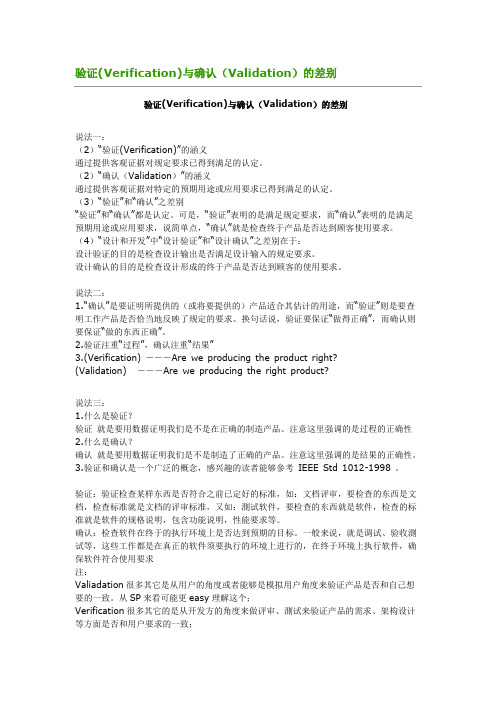
验证(Verification)与确认(Validation)的差别说法一:(2)“验证(Verification)”的涵义通过提供客观证据对规定要求已得到满足的认定。
(2)“确认(Validation)”的涵义通过提供客观证据对特定的预期用途或应用要求已得到满足的认定。
(3)“验证”和“确认”之差别“验证”和“确认”都是认定。
可是,“验证”表明的是满足规定要求,而“确认”表明的是满足预期用途或应用要求,说简单点,“确认”就是检查终于产品是否达到顾客使用要求。
(4)“设计和开发”中“设计验证”和“设计确认”之差别在于:设计验证的目的是检查设计输出是否满足设计输入的规定要求。
设计确认的目的是检查设计形成的终于产品是否达到顾客的使用要求。
说法二:1.“确认”是要证明所提供的(或将要提供的)产品适合其估计的用途,而“验证”则是要查明工作产品是否恰当地反映了规定的要求。
换句话说,验证要保证“做得正确”,而确认则要保证“做的东西正确”。
2.验证注重“过程”,确认注重“结果”3.(Verification) ---Are we producing the product right?(Validation) ---Are we producing the right product?说法三:1.什么是验证?验证就是要用数据证明我们是不是在正确的制造产品。
注意这里强调的是过程的正确性2.什么是确认?确认就是要用数据证明我们是不是制造了正确的产品。
注意这里强调的是结果的正确性。
3.验证和确认是一个广泛的概念,感兴趣的读者能够參考IEEE Std 1012-1998 。
验证:验证检查某样东西是否符合之前已定好的标准,如:文档评审,要检查的东西是文档,检查标准就是文档的评审标准,又如:測试软件,要检查的东西就是软件,检查的标准就是软件的规格说明,包含功能说明,性能要求等。
确认:检查软件在终于的执行环境上是否达到预期的目标。
Validation和Errors用法
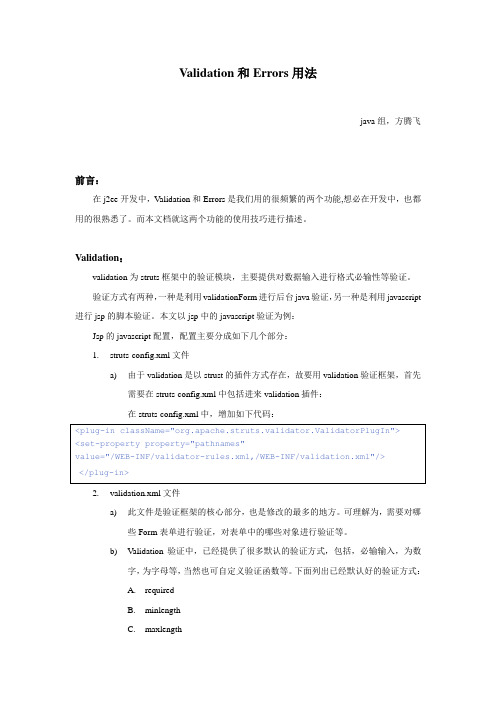
Validation和Errors用法----java组,方腾飞前言:在j2ee开发中,Validation和Errors是我们用的很频繁的两个功能,想必在开发中,也都用的很熟悉了。
而本文档就这两个功能的使用技巧进行描述。
Validation:validation为struts框架中的验证模块,主要提供对数据输入进行格式必输性等验证。
验证方式有两种,一种是利用validationForm进行后台java验证,另一种是利用javascript 进行jsp的脚本验证。
本文以jsp中的javascript验证为例:Jsp的javascript配置,配置主要分成如下几个部分:1.struts-config.xml文件a)由于validation是以strust的插件方式存在,故要用validation验证框架,首先需要在struts-config.xml中包括进来validation插件:在struts-config.xml中,增加如下代码:2.validation.xml文件a)此文件是验证框架的核心部分,也是修改的最多的地方。
可理解为,需要对哪些Form表单进行验证,对表单中的哪些对象进行验证等。
b)Validation验证中,已经提供了很多默认的验证方式,包括,必输输入,为数字,为字母等,当然也可自定义验证函数等。
下面列出已经默认好的验证方式:A.requiredB.minlengthC.maxlengthD.byteE.shortF.integerG.longH.floatI.doubleJ.dateK.rangeL.creditcardM.emailN.自定义验证表达式c)下面以例子来说明如何配置:3.资源文件a)资源文件是validation配置中的大量用到的地方,主要是对应key值。
包括上面提到的ername及username.isrequired。
b)另外,在配置其他key值的时候,需要把如下的内容默认的添加到资源文件中:c)资源文件中的{0}或{1}就是对应arg0或arg14.jsp文件a)jsp文件只需要在需要验证的页面的最后,加入如下像下面的代码即可:b)formName就是对应validation.xml文件中的form节点中name的属性值。
validation校验

validation校验validation校验所需jar包1、pom下载⽅式:12 <dependencies>3 <dependency>4 <groupId>org.jboss.logging</groupId>5 <artifactId>jboss-logging</artifactId>6 <version>3.1.4.GA</version>7 </dependency>8 <dependency>9 <groupId>javax.validation</groupId>10 <artifactId>validation-api</artifactId>11 <version>1.0.0.GA</version>12 </dependency>13 </dependencies>2、另⼀个jar包及之前pom⽂件下载⽅式中两个jar包在下⾯⽹盘链接中请下载。
微信提取:⼀、springmvc.ml中配置 validator="validator"必须指定<mvc:annotation-driven validator="validator"></mvc:annotation-driven><!--spring对校验⽂件提出的接⼝ --><bean class="org.springframework.validation.beanvalidation.LocalValidatorFactoryBean" id="validator"><!-- habernate校验器 --><property name="providerClass" value="org.hibernate.validator.HibernateValidator"></property><!-- 指定校验使⽤的资源问件位置 --><property name="validationMessageSource" ref="messageSourse"></property></bean><bean class="org.springframework.context.support.ReloadableResourceBundleMessageSource" id="messageSourse"> <property name="basenames"><list><!--校验资源⽂件信息 --><value>classpath:CustomValidationMessages</value></list></property><!--资源⽂件编码格式--><property name="fileEncodings" value="utf-8"></property><!--对资源⽂件暂存时间 --><property name="cacheSeconds" value="120"></property></bean>⼆、新建properties⽂件⽤来存⾃定义校验信息等号后⾯是uinque码因为没设置所以不显⽰中⽂。
validation的用法

validation的用法In the field of scientific research, validation plays a crucial role in establishing the credibility and integrity of experimental findings. Before a new scientific theory or hypothesis is accepted, it must undergo rigorous validation through repeated experimentation and evaluation. This process involves ensuring that the experimental procedure is reliable, the data collected is accurate, and the conclusions drawn are logical and supported by evidence. Without proper validation, scientific claims would lack credibility and could lead tofaulty assumptions and conclusions.Data validation is another critical aspect of data analysis and processing. It involves verifying the integrity and quality of data to ensure its fitness for a specific purpose. Data validation can include various checks, such as ensuring that data falls within acceptable ranges, has no missing values, meets certain statistical properties, or conforms to defined business rules. By validating data, organizations can ensurethat their decisions and actions are based on accurate and reliable information.Validation can take different forms depending on the context and requirements. For example, in the medical field, clinical trials are conducted to validate the safety and effectiveness of new drugs or treatments. These trials follow strict protocolsand guidelines to ensure that the results are scientifically valid and can be used to make informed decisions about patient care. Similarly, software validation may involve functional testing, performance testing, security testing, and user acceptance testing to ensure that the software behaves as expected and meets the user's requirements.。
validation注解及自定义注解
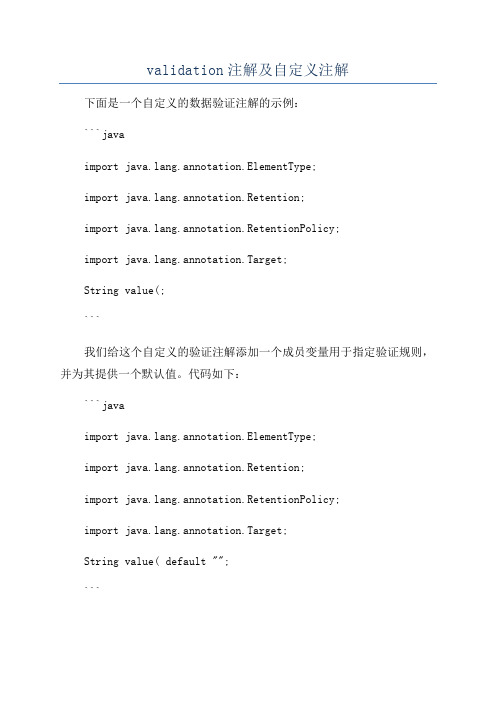
validation注解及自定义注解下面是一个自定义的数据验证注解的示例:```javaimport ng.annotation.ElementType;import ng.annotation.Retention;import ng.annotation.RetentionPolicy;import ng.annotation.Target;String value(;```我们给这个自定义的验证注解添加一个成员变量用于指定验证规则,并为其提供一个默认值。
代码如下:```javaimport ng.annotation.ElementType;import ng.annotation.Retention;import ng.annotation.RetentionPolicy;import ng.annotation.Target;String value( default "";```现在我们可以在类中的字段上使用这个自定义的注解进行数据验证了。
示例如下:```javapublic class Personprivate String name;private String phoneNumber;// other fields and methods```引入这个自定义的注解后,我们可以在应用逻辑中对这些字段进行验证。
示例如下:```javapublic class PersonValidatorpublic static void validate(Person person)Class<Person> cls = Person.class;for (Field field : cls.getDeclaredFields()if (field.isAnnotationPresent(Validation.class))Validation validation =field.getAnnotation(Validation.class);String value = validation.value(;field.setAccessible(true);tryString fieldValue = (String) field.get(person);if (!fieldValue.matches(value))throw new IllegalArgumentException("Invalid value for field " + field.getName();}} catch (IllegalAccessException e)e.printStackTrace(;}}}}```最后,我们可以在应用代码中使用这个验证器进行数据验证。
validation 同组校验顺序

validation 同组校验顺序
在进行表单验证时,同组校验顺序是非常重要的。
通常情况下,表单中有多个输入框需要验证,这些输入框可能属于同一个组,需要对这些输入框进行同组校验。
同组校验顺序在很大程度上影响了表单验证的效率和准确性。
在进行同组校验时,应该遵循以下原则:
1. 优先校验必填项:必填项是表单中最重要的信息,应该优先进行校验。
如果必填项未填写或填写不规范,应该立即提示用户进行修改。
2. 根据输入框顺序进行校验:如果输入框没有必填项的要求,那么应该根据输入框顺序进行校验。
例如,表单中的第一个输入框是姓名,第二个输入框是邮箱,那么应该先校验姓名是否符合规范,再校验邮箱是否符合规范。
3. 根据错误类型进行校验:如果同一组中的多个输入框都有可能出现某一种错误,那么应该优先校验错误类型更严重的输入框。
例如,如果同一组中的输入框有可能出现空格和非法字符,那么应该先校验非法字符的输入框。
总之,同组校验顺序应该根据实际情况来确定,以提高表单验证的效率和准确性。
- 1 -。
validation 正则
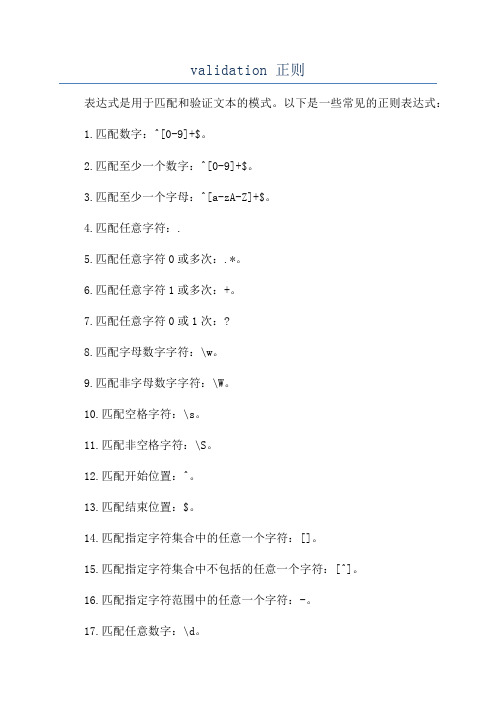
validation 正则
表达式是用于匹配和验证文本的模式。
以下是一些常见的正则表达式:
1.匹配数字:^[0-9]+$。
2.匹配至少一个数字:^[0-9]+$。
3.匹配至少一个字母:^[a-zA-Z]+$。
4.匹配任意字符:.
5.匹配任意字符0或多次:.*。
6.匹配任意字符1或多次:+。
7.匹配任意字符0或1次:?
8.匹配字母数字字符:\w。
9.匹配非字母数字字符:\W。
10.匹配空格字符:\s。
11.匹配非空格字符:\S。
12.匹配开始位置:^。
13.匹配结束位置:$。
14.匹配指定字符集合中的任意一个字符:[]。
15.匹配指定字符集合中不包括的任意一个字符:[^]。
16.匹配指定字符范围中的任意一个字符:-。
17.匹配任意数字:\d。
18.匹配非数字:\D。
19.匹配任意换行符:\n。
20.匹配任意制表符:\t。
注:正则表达式的具体规则和方法因编程语言和使用场景而异。
validation 字符串长度限制 注解
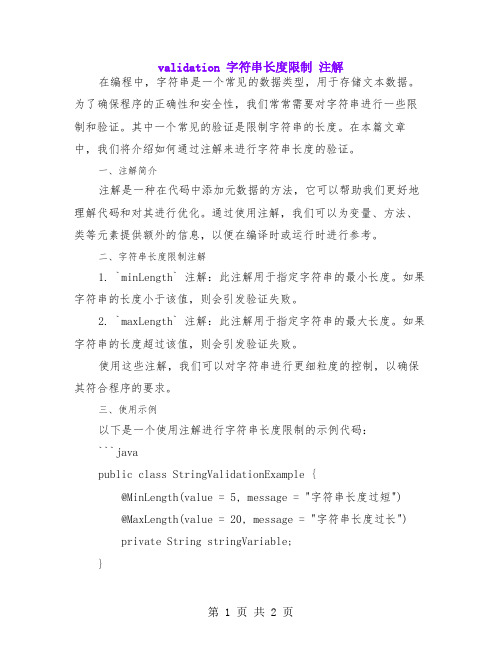
validation 字符串长度限制注解在编程中,字符串是一个常见的数据类型,用于存储文本数据。
为了确保程序的正确性和安全性,我们常常需要对字符串进行一些限制和验证。
其中一个常见的验证是限制字符串的长度。
在本篇文章中,我们将介绍如何通过注解来进行字符串长度的验证。
一、注解简介注解是一种在代码中添加元数据的方法,它可以帮助我们更好地理解代码和对其进行优化。
通过使用注解,我们可以为变量、方法、类等元素提供额外的信息,以便在编译时或运行时进行参考。
二、字符串长度限制注解1. `minLength` 注解:此注解用于指定字符串的最小长度。
如果字符串的长度小于该值,则会引发验证失败。
2. `maxLength` 注解:此注解用于指定字符串的最大长度。
如果字符串的长度超过该值,则会引发验证失败。
使用这些注解,我们可以对字符串进行更细粒度的控制,以确保其符合程序的要求。
三、使用示例以下是一个使用注解进行字符串长度限制的示例代码:```javapublic class StringValidationExample {@MinLength(value = 5, message = "字符串长度过短")@MaxLength(value = 20, message = "字符串长度过长")private String stringVariable;}```在上面的示例中,我们为 `stringVariable` 字段添加了两个注解:`@MinLength` 和 `@MaxLength`。
这些注解告诉编译器,字符串的长度必须介于 5 和 20 之间,否则将会抛出一个错误消息。
四、注意事项在使用注解进行字符串长度限制时,请注意以下几点:1. 确保注解的参数值符合预期:确保 `value` 参数的值正确设置,以符合程序的要求。
2. 考虑异常处理:在验证失败时,应该提供适当的错误消息或提示,以便用户了解发生了什么问题。
validation 枚举约束校验自定义注解

标题:枚举约束校验自定义注解的应用及实现一、概述枚举约束校验自定义注解是一种在软件开发中常用的技术,在进行数据校验和验证时十分有用。
本文将介绍枚举约束校验自定义注解的相关概念、应用场景和实现方法,以帮助读者更好地理解和运用该技术。
二、枚举约束校验的概念枚举约束校验是指在对数据进行校验时,使用枚举类型来限定数据的取值范围。
这样可以确保数据的合法性,避免无效数据的输入和处理。
而自定义注解则是在Java语言中常用的一种方式,它可以帮助开发者在代码中标记和使用特定的校验规则。
三、枚举约束校验自定义注解的应用场景1. 数据表单的校验:在前端用户输入数据提交到后端时,可以使用枚举约束校验自定义注解来验证数据的有效性,比如性莂、国家、省份等固定的枚举类型。
2. 参数传递的校验:在方法调用或接口交互的过程中,可以使用自定义注解来标记和检查参数的合法性,避免无效参数的传递。
3. 数据库查询条件的校验:在进行数据库查询操作时,可以通过自定义注解来定义查询条件的合法性,比如特定字段的取值范围。
四、枚举约束校验自定义注解的实现方法1. 定义枚举类型:首先需要定义一个枚举类型,用来表示数据的取值范围。
比如定义一个枚举类型Gender,表示性莂的取值范围为男、女和未知。
2. 定义自定义注解:接下来定义一个自定义注解,用来标记需要进行枚举约束校验的字段或方法参数。
比如定义一个EnumConstr本人nt 注解,用来标记需要进行性莂枚举校验的字段或方法参数。
3. 实现注解校验逻辑:在实现自定义注解的校验逻辑时,可以利用反射等方式获取被注解标记的字段或方法参数的取值,并与枚举类型中的取值范围进行比对。
如果不在取值范围内,则抛出校验异常。
五、实际应用案例假设有一个用户注册接口,需要对用户的性莂进行枚举约束校验。
可以按照以下步骤进行实现:1. 定义Gender枚举类型:public enum Gender {MALE, FEMALE, UNKNOWN}2. 定义EnumConstr本人nt注解:Target(ElementType.FIELD)Retention(RetentionPolicy.RUNTIME)public interface EnumConstr本人nt {Class<? extends Enum<?>> value();}3. 实现注解校验逻辑:public class EnumConstr本人ntValidator implements Constr本人ntValidator<EnumConstr本人nt, Enum> {private Class<? extends Enum<?>> enumClass;Overridepublic void initialize(EnumConstr本人nt constr本人ntAnnotation) {this.enumClass = constr本人ntAnnotation.value();}Overridepublic boolean isValid(Enum value, Constr本人ntValidatorContext context) {if (value != null enumClass.isInstance(value)) {Enum[] enumConstants =enumClass.getEnumConstants();for (Enum anEnum : enumConstants) {if (().equals(())) {return true;}}}return false;}}4. 在用户注册接口中使用EnumConstr本人nt注解:public class UserRegisterRequest {EnumConstr本人nt(Gender.class)private Gender gender;// other fields and methods}通过以上实现,当接收到用户注册请求时,可以对用户的性莂字段进行枚举约束的校验,保证注册时传入的性莂是合法的。
- 1、下载文档前请自行甄别文档内容的完整性,平台不提供额外的编辑、内容补充、找答案等附加服务。
- 2、"仅部分预览"的文档,不可在线预览部分如存在完整性等问题,可反馈申请退款(可完整预览的文档不适用该条件!)。
- 3、如文档侵犯您的权益,请联系客服反馈,我们会尽快为您处理(人工客服工作时间:9:00-18:30)。
V ALIDATION R EPORT Shandong Kenli Biomass Generation Project in China R EPORT N O. 2007-0611R EVISION N O.02D ET N ORSKE V ERITASAbbreviationsBM Build MarginCAR Corrective Action RequestCDM Clean Development MechanismCEF Carbon Emission FactorCER Certified Emission ReductionCL Clarification requestCO2Carbon dioxideCO2e Carbon dioxide equivalentDNV Det Norske VeritasDNA Designated National AuthorityDRC Development and Reform CommissionFSR feasibility study reportGHG Greenhouse gas(es)GWP Global Warming PotentialIPCC Intergovernmental Panel on Climate ChangeIRR Internal rate of returnLOA Letter of Approval.MP Monitoring PlanMVP Monitoring and Verification PlanNDRC National Development and Reforming committeeNCPG North China power gridNGO Non-Governmental OrganisationODA Official Development AssistanceOM Operating MarginPDD Project Design DocumentSCE Standard coal equivalentUNFCCC United Nations Framework Convention on Climate ChangeTABLE OF CONTENTS1 EXECUTIVE SUMMARY – VALIDATION OPINION (5)2 INTRODUCTION (6)2.1 Objective 62.2 Scope 63 METHODOLOGY (6)3.1 Desk Review of the Project Design Documentation 7 3.2 Follow-up Interviews with Project Stakeholders 9 3.3 Resolution of Outstanding Issues 10 3.4 Internal Quality Control 123.5 Validation Team 124 VALIDATION FINDINGS (13)4.1 Participation Requirements 13 4.2 Project Design 13 4.3 Baseline Determination 14 4.4 Additionality 16 4.5 Monitoring 22 4.6 Estimate of GHG Emissions 24 4.7 Environmental Impacts 26 4.8 Comments by Local Stakeholders 26 4.9 Comments by Parties, Stakeholders and NGOs 27 Appendix A: Validation ProtocolAppendix B: Certificates of Competence1EXECUTIVE SUMMARY – V ALIDATION OPINIONDet Norske Veritas Certification AS (DNV) has performed a validation of the “Shandong Kenli Biomass Generation Project” in China. The validation was performed on the basis of UNFCCC criteria for the Clean Development Mechanism and host Party criteria, as well as criteria given to provide for consistent project operations, monitoring and reporting.The review of the project design documentation and the subsequent follow-up interviews have provided DNV with sufficient evidence to determine the fulfilment of stated criteria.The host Party is China and the Annex I Party is the United Kingdom. Both Parties fulfil the participation criteria and have approved the project and authorized the project participants. The DNA from China confirmed that the project assists in achieving sustainable development. The project correctly applies ACM0006 “Consolidated baseline and monitoring methodologies for grid-connected electricity generation from biomass residues”, version 06. By burning biomass residual (cotton straw) which are currently left to decay to generate electricity and thereby replacing fossil fuel based electricity generation and avoiding methane emissions from the decay or the uncontrolled burning of cotton straw, the project results in reductions of CH4 and CO2 emissions that are real, measurable and give long-term benefits to the mitigation of climate change. It is demonstrated that the project is not a likely baseline scenario. Emission reductions attributable to the project are hence additional to any that would occur in the absence of the project activity.The total emission reductions from the project are estimated to be on the average 145 348 tCO2e per year over the selected 7 year crediting period. The emission reduction forecast has been checked and it is deemed likely that the stated amount can be achieved given that the underlying assumptions do not change.Adequate training and monitoring procedures have been envisaged.In summary, it is DNV’s opinion that the “Shandong Kenli Biomass Generation Project” in China, as described in the PDD of 31 March 2009, meets all relevant UNFCCC requirements for the CDM and all relevant host Party criteria and correctly applies the baseline and monitoring methodology ACM0006, version 06. DNV thus requests the registration of theproject as a CDM project activity.”2INTRODUCTIONNational Bio Energy Co., Ltd. has commissioned Det Norske Veritas Certification AS (DNV) to perform a validation of the “Shandong Kenli Biomass Generation Project” in China. This report summarizes the findings of the validation of the project, performed on the basis of UNFCCC criteria for CDM projects, as well as criteria given to provide for consistent project operations, monitoring and reporting. UNFCCC criteria refer to Article 12 of the Kyoto Protocol, the CDM modalities and procedures and the subsequent decisions by the CDM Executive Board.2.1ObjectiveThe purpose of a validation is to have an independent third party assess the project design. In particular, the project's baseline, monitoring plan, and the project’s compliance with relevant UNFCCC and host Party criteria are validated in order to confirm that the project design, as documented, is sound and reasonable and meets the identified criteria. Validation is a requirement for all CDM projects and is seen as necessary to provide assurance to stakeholders of the quality of the project and its intended generation of certified emission reductions (CERs).2.2ScopeThe validation scope is defined as an independent and objective review of the project design document (PDD). The PDD is reviewed against the criteria stated in Article 12 of the Kyoto Protocol, the CDM modalities and procedures as agreed in the Marrakech Accords and the relevant decisions by the CDM Executive Board, including the approved baseline and monitoring methodology ACM0006, version 06. The validation team has, based on the recommendations in the Validation and Verification Manual /14/ employed a risk-based approach, focusing on the identification of significant risks for project implementation and the generation of CERs.The validation is not meant to provide any consulting towards the project participants. However, stated requests for clarifications and/or corrective actions may have provided input for improvement of the project design.3 METHODOLOGYThe validation consisted of the following three phases:I a desk review of the project design documentsII follow-up interviews with project stakeholdersIII the resolution of outstanding issues and the issuance of the final validation report and opinionThe following sections outline each step in more detail.3.1Desk Review of the Project Design DocumentationThe following table outlines the documentation reviewed during the validation:/1/ Easy Carbon Consultancy Co. Ltd., Project Design Document for the “Shandong Kenli Biomass Generation Project”, version 1 dated 8 December 2006, version 2 dated 6September 2007, version 4 dated 17 October 2008 and version 5 dated 31 March 2009. /2/ Letter of Approval issued by DNA of China dated 2 July 2007./WebSite/CDM/UpFile/File1229.pdf/3/ Letter of Approval issued by DNA of the United Kingdom dated 11 July 2008/4/ The feasibility study report of Shandong Kenli Biomass Generation Project issued by Shangdong Luneng Electric Power Designing Institute dated April 2006 and theapproval letter by the Development and Reform Commission of Shandong Province on1 June 2006./5/ The EIA of the Shandong Kenli Biomass Generation Project on 24 January 2006 and the approval letter by Environmental Protection Bureau of Shandong Province on 10February 2006 and 30 April 2006./6/ CDM project consulting service contract with Easy Carbon Consultancy Co. Ltd. dated14 March 2006/7/ Stakeholders meeting minutes and questionnaire dated 16 January 2006/8/ “Shandong Kenli Biomass Generation Project” Plant start up procedure dated November 2006/9/ Approval for “Shandong Kenli Biomass Generation Project” construction start up permission dated 7 June 2006/10/ Notice on Strictly Prohibiting the Installation of Fuel-fired Generation with the Capacity of 135 MW or below issued by the General Office of the State Council,decree no. 2002-6/11/ Training plan and procedure issued by the Shandong Kenli Biomass Power Generation Company dated 20 August 2006/12/ Shandong Kenli Biomass Generation Co. Ltd. : Biomass residue price investigation report dated 15 February 2006/13/ The project’s operation management and monitoring manual version 1 dated October 2007/14/ EB 44 Report Annex 3: Validation and Verification Manual Version 01.http://cdm.unfccc.int/EB/044/eb44_repan03.pdf/15/ CDM Executive Board, ACM0006 version 06, “Consolidated baseline and monitoring methodologies for grid-connected electricity generation from biomass residues”/16/ CDM Executive Board, ACM0002 version 07 “Consolidated methodology for grid-connected electricity generation from renewable sources”/17/ CDM Executive Board, Combined tool to identify the baseline scenario anddemonstrate additionality (version 02.2)/18/ China Electric Power Yearbooks 2001, 2002, 2003, 2004 and 2005./19/ China Energy statistics Yearbooks 2000-2002, 2003, 2004, 2005/20/ Chinese National Standard GB2589-81/21/ CDM Executive Board, Guidance for request for deviation titled “Application of AM0005 and AMS-I.D in China” (http://cdm.unfccc.int/Projects/Deviations)/22/ IPCC 2006 Guidelines for National Greenhouse Gas Inventories/23/ State Power Corporation of China. Interim Rules on Economic Assessment of Electrical Engineering Retrofit Projects. Beijing: China Electric Power Press, 2003/24/ CDM Executive Board, Tool to calculate project emissions from electricity consumption, Version 01/25/ CDM Executive Board, Tool to calculate project emission CO2 or leakage CO2 emissions from fossil fuel combustion, Version 01/26/ Web information about biomass power project development in China:/neoman/29548/g.htm/2007/20070313/t20070313_126623.htm/2007news/2007020601.htm/27/ IRR calculation spreadsheet/28/ Interim Regulation for Tariff of Renewable Energy Power Generation and Appointment of Expenses dated 4 January 2006/29/ China Statistics Yearbook 2006 and Consumer Price Index (CPI) by Region (2006.12), and Consumer Price Index (CPI) by Region (2007.12) issued by National Bureau ofStatistics of China/tjsj/ndsj/2006/indexeh.htm and /30/ NDRC Website information about biomass residue price/zdxm/t20051229_55135.htmNDRC Website information about efficiencies of coal, oil and gas fired thermal plant/web/NewsInfo.asp?NewsId=1850/31/ Boiler technical specification (annual operation hour) source from the boiler purchasing contract/32/ Shandong Development and Reform Committee and ShanDong Province Price Bureau: Tariff for coal fired power plants in Shandong Province in 2005/33/ Purchase contract of the boiler with Longji electricity Co., Ltd. dated on 19 June 2006 /34/ Purchase contract of the generator & turbine with Wuhan turbine factory dated 22 June 2006/35/ The Board meeting minutes about developing the proposed project as a CDM projecton 24 February 2006/36/ Electricity tariff approval letter issued by Shandong province price bureau dated 23 April 2007/37/ Biomass residual purchasing contract with Shandong guoneng huida fuel company dated 1 February 2007/38/ Final accounting report issued by Shandong Kenli Biomass Power Generation Company dated 31 December 2007Main changes between the version of the PDD published for the 30 days stakeholder commenting period and the final version submitted for registration:.- The methodology has been upgraded from ACM0006 version 4 to version 06;- the project proponent company name changed from IXIS Environment & Infrastructure to NATIXIS Environment & Infrastructure- Accordingly, the tool for the demonstration of addtionality has been changed to Version 02.2 of the combined tool to identify the baseline scenario and demonstrateadditionality- Tool to calculate project emissions from electricity consumption, version 01, and Tool to calculate project emissions or leakage CO2 emissions from fossil fuel combustion,version 01, are used for emission reduction calculation;3.2Follow-up Interviews with Project StakeholdersDuring the period from 3 to 4 April 2007, the on site visit was carried out by GHG Auditor Mindy Yue to confirm selected information and to resolve issues identified in the document review. Representatives of National Kenli Bio Energy Co. and Ltd.,Easy Carbon Consultancy Co. Ltd. were interviewed to confirm selected information and to resolve the issues identified during the desk review of the project design document. Following personnel from different organisations were interviewed:Date Name Organization Topic/39/ 2007-04-04 Mr. Liu Jinzhong,General managerMr. Zhang Yuru,Deputy generalmanagerMr. Su Xi,Fuel departmentmanagerMr. Jiang Haifeng,AdministrativeassistantMr. Wang Xiaoyang,Marketing managerMr. Xiao Bing,Project manager National KenliBio Energy Co.,Ltd.-Project backgroundinformation.-Project technology,operation, maintenanceand monitoringcapability.-Project additionality.-Project monitoring andmanagement plan.-Project approval status(incl. EIA approval,CDM project approvalstatus)-Stakeholderconsultation process./40/ 2007-04-04 Mr. Guan YisongDeputy director Easy CarbonConsultancy Co.Ltd.-Applicability ofselected methodology.-Baseline determination.-Emission reductionscalculation.-Emission reductionmonitoring plan.3.3Resolution of Outstanding IssuesThe objective of this phase of the validation was to resolve any outstanding issues which needed be clarified prior to DNV’s positive conclusion on the project design. In order to ensure transparency a validation protocol was customised for the project. The protocol shows in a transparent manner criteria (requirements), means of verification and the results from validating the identified criteria. The validation protocol serves the following purposes:•It organises, details and clarifies the requirements a CDM project is expected to meet; •It ensures a transparent validation process where the validator will document how a particular requirement has been validated and the result of the validation.The validation protocol consists of two tables. The different columns in these tables are described in the figure below. The completed validation protocol for the “Shandong Kenli Biomass Generation Project” is enclosed in Appendix A to this report.Findings established during the validation can either be seen as a non-fulfilment of CDM criteria or where a risk to the fulfilment of project objectives is identified. Corrective action requests (CAR) are issued, where:i)mistakes have been made with a direct influence on project results;ii)CDM and/or methodology specific requirements have not been met; oriii)there is a risk that the project would not be accepted as a CDM project or that emission reductions will not be certified.A request for clarification (CL) may be used where additional information is needed to fully clarify an issue.Validation Protocol Table 1: Mandatory Requirements for CDM Project Activities Requirement Reference ConclusionThe requirements the project must meet. Gives reference to thelegislation oragreement where therequirement is found.This is either acceptable based on evidence provided (OK), aCorrective Action Request (CAR) of risk or non-compliancewith stated requirements or a request for Clarification (CL)where further clarifications are needed.Validation Protocol Table 2: Requirement checklistChecklist Question Reference Means ofverification (MoV) Comment Draft and/or FinalConclusionThe various requirements in Table 2 are linked to checklist questions the project should meet. The checklist is organised in different sections, following the logic of the large-scale PDD template, version 03 - in effect as of: 28 July 2006. Each section is then further sub-divided. Givesreference todocumentswhere theanswer tothe checklistquestion oritem isfound.Explains howconformance withthe checklistquestion isinvestigated.Examples of meansof verification aredocument review(DR) or interview(I). N/A means notapplicable.The section isused to elaborateand discuss thechecklist questionand/or theconformance tothe question. It isfurther used toexplain theconclusionsreached.This is either acceptablebased on evidenceprovided (OK), or ac orrective action request(CAR) due to non-compliance with thechecklist question (Seebelow). A request forclarification (CL) is usedwhen the validation teamhas identified a need forfurther clarification.Validation Protocol Table 3: Resolution of Corrective Action and Clarification RequestsDraft report clarifications and corrective action requests Ref. to checklistquestion in table 2Summary of projectowner responseValidation conclusionIf the conclusions from the draft Validation are either a CAR or a CL, these should be listed in this section. Reference to thechecklist questionnumber in Table 2where the CAR or CL isexplained.The responses given bythe project participantsduring thecommunications with thevalidation team shouldbe summarised in thissection.This section should summarisethe validation team’sresponses and finalconclusions. The conclusionsshould also be included inTable 2, under “FinalConclusion”.Figure 1 Validation protocol tables3.4Internal Quality ControlThe draft validation report including the initial validation findings underwent a technical review before being submitted to the project participants. The final validation report underwent another technical review before requesting registration of the project activity. The technical review was performed by a technical reviewer qualified in accordance with DNV’s qualification scheme for CDM validation and verification.3.5Validation TeamThe validation team consisted of the following personnel:Type of involvementRole/Qualification Last Name FirstName Country D eskreviewSitevisit/InterviewsReportingSupervisionofworkTechnicalreviewExpertinputGHG Auditor /project managerGuo Kang China √√√GHG auditor Yue Mindy China √√√CDM validator/ Technical team leader Lai CheeKeongChina √√Sector expert David Costa Brazil √Technicalreviewer (finalreport)Lehmann Michael Norway √Technicalreviewer (draftreport)Rescalvo Miguel Norway √Technicalreviewer(applicant for finalreport)Ramachandran Ramesh India √The qualification of each individual validation team member is detailed in Appendix B to this report.4V ALIDATION FINDINGSThe findings of the validation are stated in the following sections. The validation criteria (requirements), the means of verification and the results from validating the identified criteria are documented in more detail in the validation protocol in Appendix A.The final validation findings relate to the project design as documented and described in the revised and resubmitted project design documentation.4.1Participation RequirementsThe project participants are National Bio Energy Co., Ltd. of China and NATIXIS Environment & Infrastructure (formerly denominated IXIS Environment & Infrastructure) of the United Kingdom. The host Party China and the participating Annex I Party the United Kingdom meet the requirements to participate in the CDM.The DNA of China has issued a Letter of Approval (LoA) /2/on 2 July 2007, authorizing National Bio Energy Co., Ltd. as a project participant and also confirming that the project assists in achieving sustainable development. This is verified through the official NDRC’s website /2/ information dated 2 April 2007.The DNA of United Kingdom has issued a LoA/3/ dated on 11 July 2008, authorizing NATIXIS Environment & Infrastructure (formerly denominated IXIS Environment & Infrastructure) as a project participant.The validation did not reveal any information that indicates that the project can be seen as a diversion of official development assistance (ODA) funding towards China.4.2Project DesignThe project is a renewable energy project activity with an installed capacity of 30 MW (the installed capacity is updated from 25 MW to 30 MW in the feasibility study report (FSR) and has been approved by the Development and Reform Commission of Shandong Province) using biomass residues (cotton straws) as fuel and exporting generated electricity to the grid. The project is a greenfield project involving the installation of a biomass residue based combustion boiler in Kenli County, Dongying City, Shandong Province of China, employing Steam-Rankine cycle technology for generating electricity. The applied technology essentially comprises of direct combustion of biomass residues in a boiler to generate steam, which is subsequently expanded through a turbine to generate electricity. The main component of the project activity, the boiler system is based on technology from Denmark, but produced in China. The generating set and the turbine is being sourced domestically in China. DNV has assessed that the project design engineering reflects current good practices.The biomass used for power generation is cotton straw as stated in the PDD and FSR, which has been confirmed during site visit. The project includes a straw collection and treatment system with a number of collection stations, which collect straw from local farmers. The straws will then be transported to the power plant using trucks. The straws will be treated and prepared before sending to the boiler for combustion, the steam-Rankine cycle consisting ofdirect combustion of biomass in a boiler to generate steam, which will start a turbine to drivethe generator for electricity production.A renewable crediting period of 7 years is selected, starting on 1 July 2009 or the date of registration. The expected operational lifetime of the project is 21 years according to the FSR /4/.4.3Baseline DeterminationThe project applies the approved consolidated baseline methodology ACM0006 “Consolidated baseline methodology for grid-connected electricity generation from biomass residues” (version 06) /15/. ACM0006 version 06 is applicable to the project because:1.No other biomass types than biomass residues are used in the project plant and thesebiomass residues are the predominant fuel used in the project plant (some fossil fuels may be co-fired) based on the site visit and the FSR /7/, DNV is able to confirm that biomass from local agricultural residues will be used in the proposed project, and cotton straw are the predominant fuel in the proposed project.2.For projects that use biomass residues from a production process (e.g. production ofsugar or wood panel boards), the implementation of the project shall not result in an increase of the processing capacity of raw input (e.g. sugar, rice, logs, etc.) or in other substantial changes (e.g. product change) in this process. Based on the site visit and FSR /7/, DNV is able to confirm that the biomass residues consumed in the proposed project are not from any industrial production process, but cotton straws are directly from agriculture.3.The biomass residues used by the project facility should not be stored for more than oneyear: although there are three storage sites for the project, the storage capacity is limited, so that the storage time of the biomass is not expected to surpass six months (63 000 tonnes) according to FSR /4/. Furthermore, as per the stock rotation regulation of the warehouses of the project, the biomass fuels collected will be consumed on a first-come-first-used basis. Thus, the biomass residues used in the project activity will not be stored for more than one year. DNV is able to confirm that the biomass residues storage time can be controlled within one year by stock rotation.4.No significant energy quantities, except from transportation or mechanical treatment ofthe biomass residues, are required to prepare the biomass residues for fuel combustion: base on the site visit and FSR /7/, DNV is able to confirm that biomass from local agricultural residues will be the predominant fuel in the project. There is only a very small amount of diesel that will be used to help start-up the boilers; that amount will be monitored during the operation in accordance with the methodology.DNV is able to verify the above information during the site visit.The project activity complies with project scenario 2 of ACM0006 version 06, i.e. the project activity involves the installation of a new power generation plant at a site where currently no power generation occurs. The power generated by the project plant is fed into the North China Power Grid (NCPG) and would thus in the absence of the project activity be supplied by the power plants connected to the NCPG. The biomass would in the absence of the project activity be dumped or left to decay in an uncontrolled manner without utilizing it for energy purposes, which has been verified through site visit and the descriptions of biomass residuesusage and availability in the FSR and Environmental Impact Assessment of the project /4//5/.According to detailed baseline selection process as described in section 4.4. The selected baseline scenario is that in absence of the CDM project activity the electricity would have been supplied by the conventional power plants in NCPG. Scenario 2 is selected in accordance with ACM0006 version 6.2 as the baseline scenario:For power generation: P4 - The generation of power in the grid. For biomass residue use: B1 - The biomass residues are dumped or left to decay under mainly aerobic conditions.In accordance with ACM0006, a grid emission factor is calculated for the power generation baseline scenario in accordance with the tool to calculate the emission factor for an electricity system referred to by ACM0002 as a combined margin (CM) emission coefficient. The electricity system selected to determine the CM emission coefficient is NCPG. The CM emission coefficient is calculated as the weighted average of the simple operating margin (OM) and the build margin (BM).The spatial extent of the project boundary encompasses the power plant at the project site, the means for transportation of biomass to the project site and areas within 50 km around the project site which the biomass residues would have been left for decay or dumped. The electricity system considered for determining the grid emission factor includes all power plants connected physically to NCPG.For the purpose of determining GHG emissions of the project activity, the project participants decided to include the following emissions sources: the baseline emission including CO 2 emission of the grid electricity generation and CH 4 emission of the uncontrolled burning or decay of unused biomass. The project emissions are including CO 2 emission from on-site fossil fuel consumption due to the project activity and transportation of biomass, it also including the CH 4 emission of the combustion of biomass for electricity. The selected sources and gases are justified for the project activity.Source Gas Included or notJustification / ExplanationCO 2 Yes Main emission source CH 4 No Excluded for simplification. This isconservative.Grid electricity generation N 2O No Excluded for simplification. This isconservative.CO 2 No It is assumed that CO 2 emissions from surplusbiomass residues do not lead to changes of carbon pools in the LULUCF sector. CH 4 Yes B1 is the most likely baseline scenario. Baseline Uncontrolled burning or decay of surplus biomass N 2O No Excluded for simplification. This isconservative.CO 2 Yes Included as emission sources by project activity Project Activity On-site fossilfuelconsumption due to the project activity CH 4 No According to methodology, it is excluded for simplification. This emission source is assumed to be very small.。
